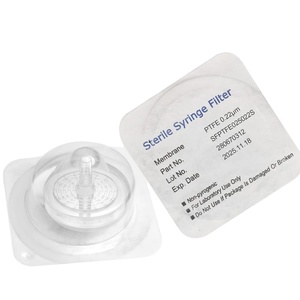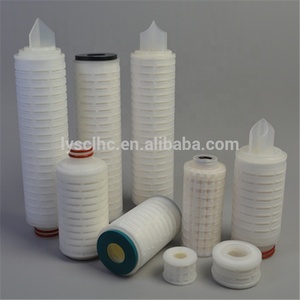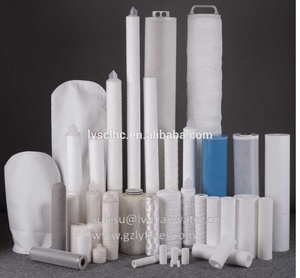(4902 products available)






















































































































































































































The primary function of the nylon membrane is to subject the liquid or slurry to the pressure of the filtrate, which cannot penetrate the membrane. Regardless of the popularity of animal collagen membranes, synthetic nylon membranes are gaining popularity due to their affordability and convenience of use. Synthetic membranes can be used as alternatives for filtration and separation in several industries.
Nylon Microfiltration Membrane:
The nylon Microfiltration Membrane filters out microorganisms and debris. It usually has pore sizes of about 0.2 to 5 micrometers, allowing liquids and smaller particles to pass through while retaining larger particles. This membrane is widely used in the food and beverage industries. For instance, it is applied to clarify liquids, remove specific microorganisms, and protect bottling lines from contamination.
Nylon Ultrafiltration Membrane:
The Nylon ultrafiltration membranes have smaller pore sizes than microfiltration membranes, typically in the range of 0.001 to 0.1 micrometers. This allows them to retain macromolecules, proteins, and even some lower-molecular-weight solutes while letting water and smaller ions pass through. They are widely used in the water purification industry to remove specific contaminants, dissolved organic matter, and natural organic matter to produce higher-quality water for subsequent treatment processes or direct consumption.
Nylon Nanofiltration Membrane:
A nanofiltration membrane has even smaller pores than ultrafiltration membranes, typically in the range of 0.0001 to 0.001 micrometers. Nylon nanofiltration membranes can remove divalent and multivalent ions and organic compounds but allow monovalent ions (e.g., sodium and chloride) and water to pass through. These membranes are employed to remove hardness and specific organic molecules from water, often as part of a desalination process in conjunction with reverse osmosis membranes.
Nylon Reverse Osmosis (RO) Membrane:
These membranes have the smallest pores in the nylon membranes series, typically in the range of 0.0000001 micrometers. The nylon RO membranes filter out virtually all contaminants, including dissolved salts, heavy metals, bacteria, and viruses. They are used for seawater desalination, removing salt from seawater to produce freshwater for drinking or industrial use. Reverse osmosis membranes are also applied in wastewater treatment plants to recover water for reuse in industrial processes or to produce drinking water in areas with limited water resources.
Generally, nylon membrane specifications will vary depending on the specific application, manufacturer, and type of nylon membrane product. The core specs include thinness, length and width, membrane strength, permeability, and filtering precision.
Thickness
The thickness of nylon membranes will differ according to usage. For instance, nylon filter membranes used in labs typically range from 5 to 25 microns.
Length and Width
Nylon membranes are usually manufactured in roll format. The length and width can vary. For example, nylon mesh membranes used for machine protection may be 1x1 inch in square length, while membranes used for dewatering may be in a roll 4m wide and 50m long.
Membrane Strength
The tensile strength of the nylon membrane is crucial, as a higher strength means the membrane will have better resilience and a longer lifespan.
Permeability
Permeability indicates how easily fluids can pass through the nylon filter membrane. High permeability membranes are suitable for rapid filtration; low permeability membranes are more for fine filtration.
Filtration Precision
Nylon filter membranes can be divided into microfiltration, ultrafiltration, nanofiltration, and other types according to their filtration precision. Microfiltration nylon membranes can filter out particles and microorganisms in the water. Ultrafiltration membranes can remove larger molecules, while nanofiltration membranes can remove specific ions and smaller molecules.
Nylon membranes serve a significant purpose in various applications; therefore, a reasonably maintenance schedule for them is paramount. Some useful maintenance tips are as follows:
When choosing a nylon membrane filter, business buyers should consider the following key factors.
Pore Size and Structure
The pore size and structure of the nylon membrane filter are decisive factors that determine its separation capacity. Filters with different pore sizes are available to cater to specific applications and fluid types. Buyers should select the appropriate pore size to ensure that the membrane can effectively separate target substances. Moreover, consider the membrane's structure, such as whether it is flat, capsule, or cartridge-shaped, to ensure compatibility with the intended filtration system.
Chemical Compatibility
Chemical compatibility is crucial for the performance and longevity of the nylon filter membrane. Different chemicals can affect the membrane's integrity and separation efficiency. Therefore, buyers must choose filters with membranes compatible with the chemicals used in their applications. This selection will help avoid damage or degradation and ensure reliable filtration.
Flow Rate and Retention
The flow rate of the nylon filter membrane determines the filtration speed, while the retention refers to its ability to retain specific substances. Buyers need to balance the flow rate and retention according to their requirements. Consider the desired filtration speed and the need to retain specific particles or organisms. Selecting membranes that provide an optimal combination of flow rate and retention will enhance the efficiency of the filtration process.
Durability
The durability of the nylon membrane is crucial for its performance and cost-effectiveness. Buyers should consider factors such as the membrane's resistance to physical stress, temperature stability, and resilience to chemical degradation. Selecting durable membranes can withstand demanding operating conditions reduces the need for frequent replacements.
Supplier Reputation
Choosing a reputable supplier is vital in ensuring the quality and reliability of the nylon mesh membrane filter. Buyers should research and evaluate different suppliers, considering their experience, manufacturing standards, quality assurance systems, and customer reviews. Selecting filters from reputable suppliers ensures that buyers benefit from reliable products and excellent customer support.
Q1: What advantages does nylon membrane filtration offer over other membrane types?
A1: Nylon membrane filtration has multiple benefits, such as sturdiness, widespread use, ease of use, and low cost. It can withstand pressure, heat, and chemical substances, making it suitable for various applications. Moreover, it can filter various chemical compounds, bacteria, and viruses. Operating a nylon membrane filter is easy as it often has simple connecting points. It is also low cost compared to other membrane filters. All these features make nylon membrane filtration surpass many other membrane types.
Q2: Are nylon membranes biodegradable?
A2: Synthetic polymers, such as nylon, are not biodegradable, which means they will not break down naturally in the environment. Nevertheless, they can recycle nylon membranes, reducing the need for new plastic production and minimizing waste.
Q3: What are the trends in the nylon membrane market?
A3: The demand for high-performance nylon membranes in diverse industries, such as food and beverage, water treatment, pharmaceuticals, and chemicals, continues to increase. This drives the development of innovative products with enhanced efficiency and durability. At the same time, the focus on sustainable practices is prompting the adoption of recyclable nylon membranes that can be used in cross-flow filtration. Moreover, automation and digitization are reshaping the membrane filtration industry by streamlining processes and improving system control.